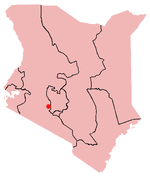
Lake Naivasha
Did you know...
SOS Children produced this website for schools as well as this video website about Africa. SOS Child sponsorship is cool!
Lake Naivasha is a freshwater lake in Kenya, lying north west of Nairobi, outside the town of Naivasha. It is part of the Great Rift Valley.
The name derives from the local Maasai name Nai'posha, meaning "rough water" because of the sudden storms which can arise. The lake has a surface area of 139 km², and is surrounded by a swamp which covers an area of 64 square km, but this can vary largely depending on rainfall. It is situated at an altitude of 1,884 metres (6,180 ft). The lake has an average depth of 6 m (20 ft), with the deepest area being at Crescent Island, at a maximum depth of 30 m (100 ft).
Njorowa Gorge used to form the lake's outlet, but it is now high above the lake and forms the entrance to Hell's Gate National Park.
The lake is home to a variety of wildlife; over 400 different species of bird have been reported. There is a sizeable population of hippos in the lake. There are two smaller lakes in the vicinity of Lake Naivasaha: Lake Oloiden and Lake Sonachi (a green crater lake). The Crater Lake Game Sanctuary lies nearby, while the lake shore is known for its population of European immigrants and settlers.
Between 1937 and 1950 the lake was used as a landing place for flying boats on the Imperial Airways passenger and mail route from Southampton in Britain to South Africa. It linked Kisumu and Nairobi.
Joy Adamson, the author of Born Free, lived on the shores of the lake in the mid-1960s.
Also on the shores of the lake is the Djinn Palace, which gained notoriety in the Happy Valley days between the two world wars. It now forms part of the Oserian flower farm.
Floriculture forms the main industry around the lake. However, the largely unregulated use of lake water for irrigation is reducing the level of the lake and is the subject of concern in Kenya. Fishing in the lake is also another source of employment and income for the local population. The lake varies in level greatly and almost dried up entirely in the 1890s. Having refilled, water levels are now dropping again.
The town of Naivasha (formerly East Nakuru) lies on the north east edge of the lake.
Industry
In 1981, the first geothermal plant for Lake Naivasha was commissioned and by 1985, a total of 45 MW of electricity was being generated in the area.
The water level for Lake Naivasha reached a low level of 0.6 m depth in 1945, but the water level rose again, with minor drops, to reach a maximum depth nearly 6 m in 1968. There was another major decline of the water level in 1987, when the depth reached 225 cm above the lake bottom.
The decline of the lake water level in 1987 increased concern in the future of geothermal industry, and it was speculated that Lake Naivasha underground water might be feeding the geothermal reservoir at Olkaria. Hence, the decline in the lake water would affect the future of the geothermal industry.



